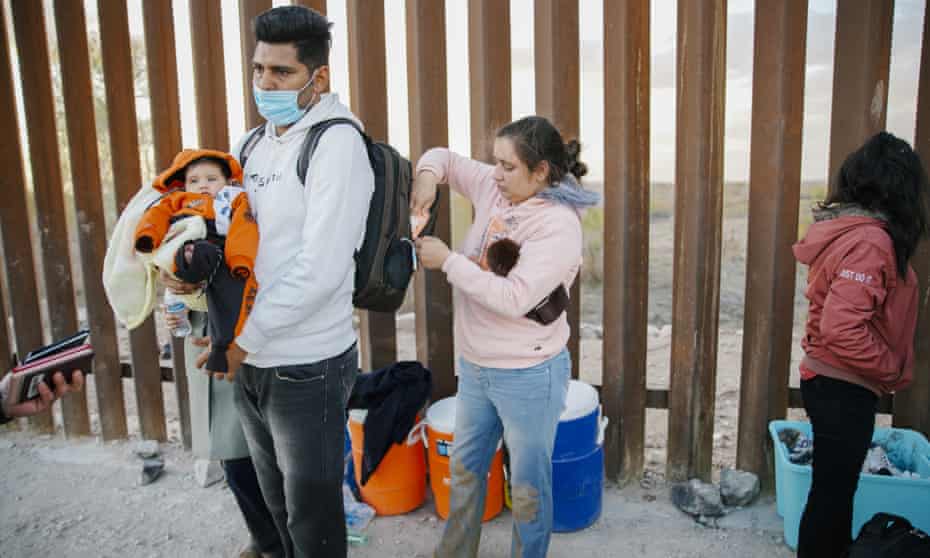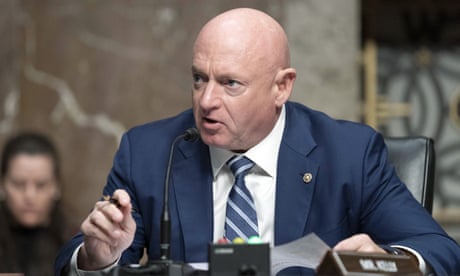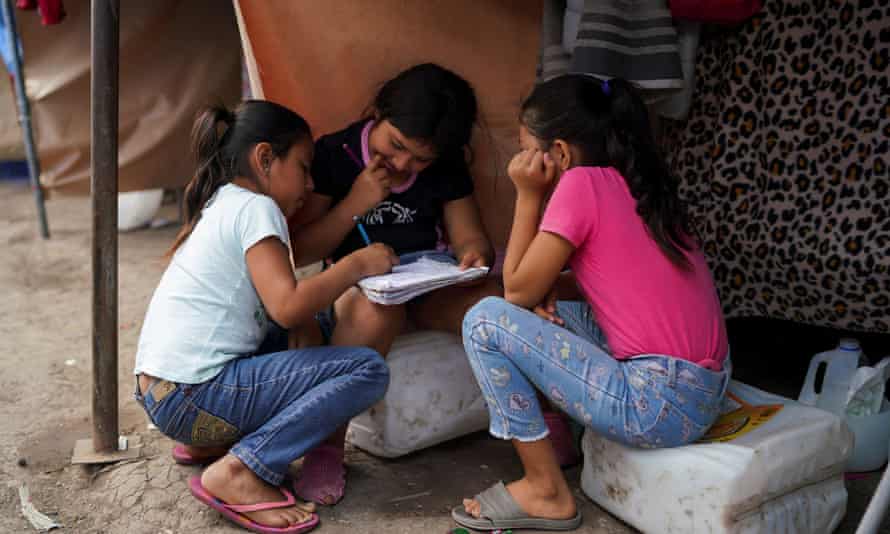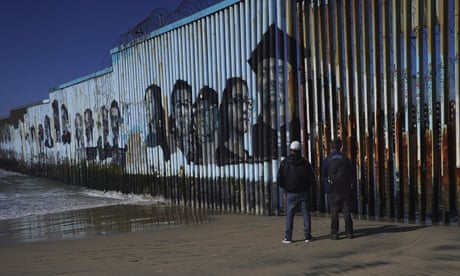Biden administration belatedly reversed a hard-right assault but humanitarian concerns risk being swamped by politics

A family seeking asylum in the US give their documents to US border patrol after crossing from Mexico in Yuma, Arizona, on 22 February.
Photograph: Anadolu Agency/Getty Images
Oliver Laughland
Oliver Laughland
THE GUARDIAN
@oliverlaughland
@oliverlaughland
Sun 3 Apr 2022
As the Biden administration announced on Friday plans to end Covid-related restrictions for undocumented people arriving at the southern border, it guaranteed that irregular immigration will return as even more of a polarizing, point-scoring, policy debate.

Biden ends Trump-era asylum curbs amid border-region Democrat backlash
And as the US hurtles toward midterm elections, another prescient anniversary looms this week.
April 6 marks four years since the Trump administration announced its “zero tolerance” policy, the mechanism through which it separated almost 4,000 children from their families in what was widely condemned as an inhumane deterrence effort. Since the practice ended a few months after it was rolled out amid outcry, border policy has lurched from one extreme strategy to another.
From “Remain in Mexico”, which pushes asylum seekers back across the border while their cases are processed, to Title 42, the public health order that has allowed border officials to rapidly expel migrants due to the Covid-19 pandemic, before they could claim asylum.
On Friday, the Centers for Disease Control and Prevention (CDC) announced the policy will finally end on 23 May.
It had been sanctioned by Donald Trump, amid lobbying from senior adviser Stephen Miller, but continued into the Biden era, with the majority of the 1.7 million expulsions under Title 42 occurring under the current president. Joe Biden only recently moved to exclude unaccompanied minors from the sweeping program.
Child separation. Remain in Mexico. The use of Title 42. All separate policies born of the same administration and indicative of a profound, hard-right assault on the right to claim asylum in the US.
“The end of the cruel and anti-immigrant policy of using Title 42 to expel vulnerable asylum seekers under public health provisions is long overdue,” said Allen Orr, president of the American Immigration Lawyers Association in a statement. “The thousands upon thousands of migrants, from babies to grandmothers, who were illegally expelled before being allowed to have a meaningful chance to claim protection under our laws merit an acknowledgment that the US got it wrong.”
Before the announcement to end use of Title 42 was made by the Biden administration this week, the White House acknowledged that winding down the provisions would probably lead to an increase in arrivals at the southern border.
As the Biden administration announced on Friday plans to end Covid-related restrictions for undocumented people arriving at the southern border, it guaranteed that irregular immigration will return as even more of a polarizing, point-scoring, policy debate.

Biden ends Trump-era asylum curbs amid border-region Democrat backlash
And as the US hurtles toward midterm elections, another prescient anniversary looms this week.
April 6 marks four years since the Trump administration announced its “zero tolerance” policy, the mechanism through which it separated almost 4,000 children from their families in what was widely condemned as an inhumane deterrence effort. Since the practice ended a few months after it was rolled out amid outcry, border policy has lurched from one extreme strategy to another.
From “Remain in Mexico”, which pushes asylum seekers back across the border while their cases are processed, to Title 42, the public health order that has allowed border officials to rapidly expel migrants due to the Covid-19 pandemic, before they could claim asylum.
On Friday, the Centers for Disease Control and Prevention (CDC) announced the policy will finally end on 23 May.
It had been sanctioned by Donald Trump, amid lobbying from senior adviser Stephen Miller, but continued into the Biden era, with the majority of the 1.7 million expulsions under Title 42 occurring under the current president. Joe Biden only recently moved to exclude unaccompanied minors from the sweeping program.
Child separation. Remain in Mexico. The use of Title 42. All separate policies born of the same administration and indicative of a profound, hard-right assault on the right to claim asylum in the US.
“The end of the cruel and anti-immigrant policy of using Title 42 to expel vulnerable asylum seekers under public health provisions is long overdue,” said Allen Orr, president of the American Immigration Lawyers Association in a statement. “The thousands upon thousands of migrants, from babies to grandmothers, who were illegally expelled before being allowed to have a meaningful chance to claim protection under our laws merit an acknowledgment that the US got it wrong.”
Before the announcement to end use of Title 42 was made by the Biden administration this week, the White House acknowledged that winding down the provisions would probably lead to an increase in arrivals at the southern border.

Migrants and border activists marched at the San Ysidro port of entry to protest against Title 42 in Tijuana, Mexico, last month.
Photograph: Carlos A Moreno/Zuma Press Wire/Rex/Shutterstock
“We are planning for multiple contingencies, and we have every expectation that when the CDC ultimately decides it’s appropriate to lift Title 42, there will be an influx of people to the border,” said the White House communications director, Kate Bedingfield, at a press briefing on Wednesday.
The Department of Homeland Security has said it is preparing to manage as many as 18,000 encounters on the border a day and is preparing to surge staff to the region to assist with enforcement and detention.
But, say advocates and lawyers operating in the region, such a rise in numbers is probably a direct consequence of the outgoing policy itself.
They point to the fact that many of those expected arrivals will be from people seeking asylum who were previously barred from doing so over the past two years.
“A post-Title 42 world at the border is simply a return to lawful processing under the asylum system that was set up by Congress decades ago,” said Shaw Drake, a staff attorney at the ACLU Texas, speaking to the Guardian shortly before the CDC announcement on Friday.
“When you spend the first year or more of your administration expelling over a million people then you are setting yourself up for an increase in people arriving to the border once that policy is lifted,” Drake, who is based in El Paso, added. “Because … you expelled people who otherwise may have had protection claims that they need to continue in the US to protect themselves from ongoing persecution and danger.”
Many of those expelled under the policy have returned to camps along the border where extortion, kidnapping and violence are routinely reported, according to lawyers.
“In any given border city [in Mexico] there are thousands of migrants some of whom have been there for over a year, already returned under Title 42,” said immigration attorney Jodi Goodwin, who is based in Harlingen, Texas.
She added: “I think the reality is that [Title 42] did nothing to help public health. There was still international movement into the US. I think it was a very thinly – veiled cover for racism, specifically targeted at Central Americans and Haitians.”
“We are planning for multiple contingencies, and we have every expectation that when the CDC ultimately decides it’s appropriate to lift Title 42, there will be an influx of people to the border,” said the White House communications director, Kate Bedingfield, at a press briefing on Wednesday.
The Department of Homeland Security has said it is preparing to manage as many as 18,000 encounters on the border a day and is preparing to surge staff to the region to assist with enforcement and detention.
But, say advocates and lawyers operating in the region, such a rise in numbers is probably a direct consequence of the outgoing policy itself.
They point to the fact that many of those expected arrivals will be from people seeking asylum who were previously barred from doing so over the past two years.
“A post-Title 42 world at the border is simply a return to lawful processing under the asylum system that was set up by Congress decades ago,” said Shaw Drake, a staff attorney at the ACLU Texas, speaking to the Guardian shortly before the CDC announcement on Friday.
“When you spend the first year or more of your administration expelling over a million people then you are setting yourself up for an increase in people arriving to the border once that policy is lifted,” Drake, who is based in El Paso, added. “Because … you expelled people who otherwise may have had protection claims that they need to continue in the US to protect themselves from ongoing persecution and danger.”
Many of those expelled under the policy have returned to camps along the border where extortion, kidnapping and violence are routinely reported, according to lawyers.
“In any given border city [in Mexico] there are thousands of migrants some of whom have been there for over a year, already returned under Title 42,” said immigration attorney Jodi Goodwin, who is based in Harlingen, Texas.
She added: “I think the reality is that [Title 42] did nothing to help public health. There was still international movement into the US. I think it was a very thinly – veiled cover for racism, specifically targeted at Central Americans and Haitians.”

Elvia, ninr, Sarai, 10, and Yadira, 8eight, asylum seekers from Central America, at a migrant camp at the border in Reynosa, Mexico, on Friday.
Photograph: Veronica Cardenas/Reuters
Goodwin said she had recently spoken to one of her clients at a camp in the border city of Matamoros who informed her that her young daughter had recently been sexually assaulted there.
“Where’s the justice? It’s not going to happen. And there are just … a lot of cases like that.”
But the humanitarian consequences of Title 42 and policies such as Remain in Mexico, which Biden initially lifted but was reinstated by court order, along with the nuances around projected increases in crossings, appear to have already been lost in partisan rhetoric.
As soon as the decision on Title 42 was announced on Friday, Republicans condemned the move, as the party gears up to force the issue as a wedge throughout the midterm election season.
The Texas senator Ted Cruz argued the decision would “open the flood gates to more illegal crossings”. Florida Republican senator Rick Scott described it as an “unconscionable plan”.
Centrist Democrats too, had begun publicly urging the president not to revoke the directive. On Friday, the West Virginia senator Joe Manchin described the announcement as a “frightening decision”. He described the Trump-era policy as “an essential tool in combatting the spread of Covid-19 and controlling the influx of migrants at our southern border”.
Those on the ground, too, say there is, as yet, no clear guidance for how exactly the processing of asylum claims might change when the order is lifted.
Last week, the Biden administration finalized plans to streamline the asylum application process, meaning applicants could have their claims of credible fear of returning to their countries of origin assessed by customs and border officials rather than immigration judges, due to chronic and growing backlogs in the immigration courts.

US immigration courts struggle amid understaffing and backlog of cases
But a continued rise in border arrivals will require greater humanitarian assistance in the region too.
“Humanitarian, on-the-ground NGOs have been preparing for this for two years,” said Karla Vargas, a senior attorney with the Texas Civil Rights project, “but whenever DHS talks about preparation [for a rise in border arrivals] there tends to be a focus on enforcement only. But there really does need to be more focus on the processing of these individuals.
“Most of the folks who are waiting that we have spoken to are just regular people, wanting to ask for asylum. To access that right.”
Goodwin said she had recently spoken to one of her clients at a camp in the border city of Matamoros who informed her that her young daughter had recently been sexually assaulted there.
“Where’s the justice? It’s not going to happen. And there are just … a lot of cases like that.”
But the humanitarian consequences of Title 42 and policies such as Remain in Mexico, which Biden initially lifted but was reinstated by court order, along with the nuances around projected increases in crossings, appear to have already been lost in partisan rhetoric.
As soon as the decision on Title 42 was announced on Friday, Republicans condemned the move, as the party gears up to force the issue as a wedge throughout the midterm election season.
The Texas senator Ted Cruz argued the decision would “open the flood gates to more illegal crossings”. Florida Republican senator Rick Scott described it as an “unconscionable plan”.
Centrist Democrats too, had begun publicly urging the president not to revoke the directive. On Friday, the West Virginia senator Joe Manchin described the announcement as a “frightening decision”. He described the Trump-era policy as “an essential tool in combatting the spread of Covid-19 and controlling the influx of migrants at our southern border”.
Those on the ground, too, say there is, as yet, no clear guidance for how exactly the processing of asylum claims might change when the order is lifted.
Last week, the Biden administration finalized plans to streamline the asylum application process, meaning applicants could have their claims of credible fear of returning to their countries of origin assessed by customs and border officials rather than immigration judges, due to chronic and growing backlogs in the immigration courts.

US immigration courts struggle amid understaffing and backlog of cases
But a continued rise in border arrivals will require greater humanitarian assistance in the region too.
“Humanitarian, on-the-ground NGOs have been preparing for this for two years,” said Karla Vargas, a senior attorney with the Texas Civil Rights project, “but whenever DHS talks about preparation [for a rise in border arrivals] there tends to be a focus on enforcement only. But there really does need to be more focus on the processing of these individuals.
“Most of the folks who are waiting that we have spoken to are just regular people, wanting to ask for asylum. To access that right.”
No comments:
Post a Comment